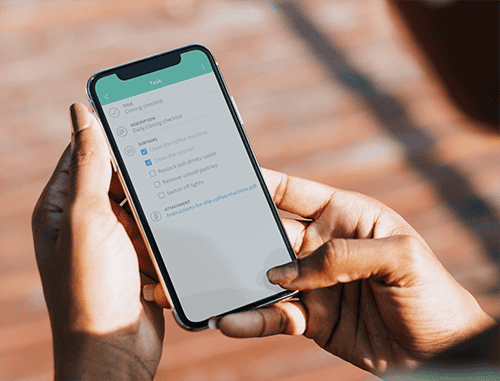Predictive Scheduling Laws: What Every Business Needs To Know
Cities and states across the country are slowly passing predictive scheduling la...

Want to improve productivity, employee satisfaction, recordkeeping, and payroll all in one fell swoop? Streamline your employee clock-in/clock-out process.
An effective time-tracking program can help make daily work activities easier to manage and help simplify the more complex jobs — like payroll and compliance — that you have to deal with on a regular basis.
In this article, we discuss some of the best ways to make your business’s time tracking-program more efficient and effective for everyone involved.

Complying with the rules and regulations of the Fair Labor Standards Act (FLSA) is an important part of running a successful business.
A simple and effective clock-in/clock-out process can help you accumulate and maintain accurate records for metrics such as:
Without a good time-tracking process, managing all of this data for short- and long-term use can be a logistical nightmare.
Left unchecked, time theft can dramatically affect your business and your bottom line.
Maintaining a simple and effective clock-in/clock-out process can help cut down on activities like:
Some time tracking programs even make use of advanced tools such as geofencing — virtual borders around a job site that restrict an employee’s ability to clock in and out to that location — and two-factor verification to prevent time theft in all its forms.
Time and attendance management is a big part of what makes many businesses successful, and the clock-in/clock-out process plays a pivotal role in making it all work.
Keeping your team on track — and on task — for success can be a difficult job all by itself. With a streamlined time tracking program and the numbers it produces, you may be much better positioned to help your employees concentrate their efforts where they’re needed the most.
Your business’s time tracking program can also help you maintain accurate attendance so that you know your employees are on the job when they should be.
It’s not uncommon for one or a handful of employees to get more hours than other employees. That could be for a reason (e.g., seniority, skill set, etc.), but it could also be due to a simple error during the scheduling process.
With the data that a good time-tracking process provides, you may be better positioned to maintain consistent hours for all employees and avoid scheduling issues that can lead to overtime, hurt feelings, and burnout.

Mounting a time clock on the wall or downloading an app onto a device and telling your team to use it will only go so far. You’re also going to need a time-tracking policy to go with it.
An effective policy includes:
Make this policy available to everyone on your team by publishing it in the employee handbook, posting it in the cloud, or saving it in a shared drive on your network so individuals can access it any time they have a question or an issue.hing it in the employee handbook, posting it in the cloud, or saving it in a shared drive on your network so individuals can access it any time they have a question or an issue.
It doesn’t matter if everyone on your team works in-office, remotely, or a combination of the two, modern time-tracking apps are the best way to streamline the clock-in/clock-out process.
In many cases, employees can use the app on their personal device (smartphone, tablet, laptop, or desktop) to start and stop their time for different tasks and jobs wherever they may have to work — be it on-site or off.
And even if your business still needs to maintain a single point of entry for all employees, time-tracking apps may be an effective upgrade for the analog punch clock and punch cards that you currently use.

However you choose to structure your clock-in/clock-out process — and whatever software you choose to use — it’s important to make the system as easy to use as possible.
If your team members have trouble with the simple act of recording one data point (e.g., their start time), they may be much more likely to stop using the whole system correctly or altogether.
This can lead to problems down the road — for them and for you — that may not be easy to overcome or resolve.
Choose an app that is user-friendly, has a one-touch interface, and doesn’t require a lot of skill or training to operate.
Regardless of the system you put in place, it’s essential to train your employees to use the software and hardware correctly if you want good results.
Yes, some team members may be able to follow the written instructions you put together, but others may need hands-on training before they feel comfortable enough to navigate the process efficiently and effectively.
Consider scheduling training sessions so everyone gets a chance to operate the equipment and ask questions before the system goes live.
It’s also a good idea to incorporate time clock training into your onboarding process so all new employees know how to clock in and clock out when necessary.
It may be a bit more work for them, but encourage your team to use advanced features of the process — like tags and entry descriptions — if they’re available.
Tagging time entries can help you and your employees sort work hours by client, job, or team (just to name a few) so that everyone involved can better understand how they’re spending their time and how they can improve.
Similarly, entry descriptions — text that explains what an employee did during a certain period of time — can be a big help when it comes time to verify timesheets and when you want to verify that everyone is working where, and on what, they’re supposed to.
When it comes to streamlining your clock-in/clock-out process, few things beat first-hand experience.
Take the time to use the system yourself in a variety of situations (e.g., starting your day, ending your day, and tracking time on task) so you know what your team has to contend with to do their jobs correctly.

Some advanced employee management apps come with powerful geofencing capabilities that allow you to create virtual boundaries around your business.
With those boundaries in place, you can then set the software to react in a certain way depending on whether an employee is inside or outside the lines when they try to clock in or clock out.
For example, with Sling, you can build geofences around both your first and second location and instruct the system not to let anyone clock in until they are inside the work area.
You can also set the app to send a notification if an employee tries to start their time in the wrong location. Similarly, you can set the software to stop tracking time if an employee moves from inside the geofence to outside the geofence.
This is extremely useful for preventing forgotten clock-outs (a form of time theft), coordinating activities at multiple locations, controlling overtime, and reducing the operating costs of your business.
Regardless of the security you have in place, there’s always the possibility that someone will find a way to cheat the system and steal time and money from your business.
Common examples of time theft include:
Make it a point to review time-tracking activity every week or every few days to prevent time theft from taking root in your system.
Implementing game elements into the time-tracking workflow is an effective way to improve the clock-in clock-out process and get full buy-in from all your employees.
There are many ways to add a bit of fun to the repetitive act of starting and stopping work time, but here are some ideas to get you started.
Set up a reward system and give out prizes or points for:
If you want to add a social element to the process, divide employees into teams and encourage friendly competition for a collective prize.
Ultimately, the game elements you choose to implement in your clock-in clock-out system will depend on the type of process you have in place. Keep in mind that what works for one business may not work for another business.
Many businesses these days have several different types of employees on the payroll, including various combinations of:
Problem is, what works for in-office employees (e.g., a single-point-of-entry time tracking model) won’t necessarily work for remote employees.
If you find yourself in the position of trying to manage dramatically different clock-in clock-out processes, implement an employee management app into your workflow.
Advanced apps like Sling make it easy for you to transform any device into a time-tracking tool so that, regardless of where and when your employees work, they’ll be able to clock in and out efficiently and accurately every time.

Regardless of whether you’re building a new process or trying to improve an existing one, take some time to research federal, state, and local laws on the subject. These laws will give you a framework on which to build the rest of your time-tracking system.
As you dig deeper into the regulations, you’ll find that much of the work has already been done for you. All you need to do is set up your process so that it complies with the federal, state, and local laws that apply to your industry and your business.
You may have the freedom to add pieces here and there, but, for the most part, the broad strokes of the process are already set in a specific way.
Good resources include:
As you research, look for information about:
If you have any questions about the mandatory parts of the time-tracking process, consult with an attorney who is familiar with your business and the area in which you operate.
You can choose between one of two time formats for tracking time:
Standard Format starts over every twelve hours and relies on the a.m. or p.m. indicator to tell you when an employee worked.
Military Format starts over every 24 hours and doesn’t need the indicator to tell you when an employee worked.
Here is how the two formats compare:
Standard Format: Penny clocks in at 8:00 a.m. and clocks out at 6:00 p.m. How many total hours did she work? There’s no direct formula to calculate her work time so you’re going to have to perform some roundabout math to figure out how long she was in the office.
Military Format: Penny clocks in at 0800 and clocks out at 1600 (the same hours as in the standard format example). How many total hours did she work? Subtract 0800 from 1600 and you can quickly see that Penny worked eight hours that day.
When choosing between Standard Format and Military Format, keep in mind that you can always switch from one to the other — even in an existing system.
As you research federal, state, and local laws, you’ll discover that businesses can round all time-tracking numbers to the nearest 10- or 15-minute increment.
So, for example, if you chose the 10-minute rounding option, any times with a one, two, three, or four at the end would round down to the nearest ten minutes (7:01, 7:02, 7:03, and 7:04 would round down to 7:00).
Any times with a five, six, seven, eight, or nine at the end would round up to the nearest ten minutes (7:05, 7:06, 7:07, 7:08, and 7:09 would round up to 7:10).
Take advantage of these rounding rules so that your payroll, recordkeeping, and business metrics don’t become unnecessarily complicated.
With the move to digital time-tracking systems, business owners and managers now have the option to automate a good portion of the process. Take advantage of this whenever possible.
Software solutions like the Sling app allow you to set a wide variety of variables and apply them to every clock-in and clock-out that occurs.
For example, you can:
Automation like this can help you and your team save time at all stages of the time-tracking process.
For more information on how to apply automation to your clock-in clock-out process, check out these articles from the Sling blog:
Software integrations are an effective way to improve a wide range of processes within your business — not just the clock-in/clock-out system.
For example, adding a point-of-sale integration to your time-tracking software (or vice versa) can give you even more insight into how your sales compare to your labor costs and what you can do to control them both.
And this is just the tip of the integrations iceberg. Advanced workforce management software like Sling works seamlessly with:
Experiment with these integrations and discover new, more effective, ways to run your business.

For busy restaurant managers, creating a streamlined clock-in/clock-out process can be challenging. In many cases, a single employee may perform different jobs at different pay rates all within the span of a single shift.
What’s the best way to make all of that as easy as possible? Implement a time tracking app into your workflow.
Some advanced options — like Sling — even allow employees to start and stop time right from their own personal device so they can switch tasks (and pay rates) without having to waste time returning to a central kiosk.
The mobility and flexibility that come with modern time tracking software may help you improve the workflow in your restaurant so that maintaining accurate time and attendance — for as many jobs and pay rates as you need — is as easy as possible for you and your team.

Whether you run a small business with a handful of employees, a growing restaurant with 20 employees, or an enterprise-scale business with 100 or more employees, an advanced clock-in/clock-out app, like Sling, can help you simplify the time-tracking process for everyone.
The Sling software suite gives managers the power to organize, optimize, and track time for a workforce of any size and location with mobile and on-site tools such as:
And, Sling can grow with your business so that when it’s time to expand from 10 to 20 to 100 employees, you and your team don’t have to go through the headache of implementing and learning new software.
Try Sling for free today to experience firsthand how the workforce management app can help you manage a team of any size and make the clock-in/clock-out process as simple as possible.
This content is for informational purposes and is not intended as legal, tax, HR, or any other professional advice. Please contact an attorney or other professional for specific advice.
See Here For Last Updated Dates: Link
Schedule faster, communicate better, get things done.